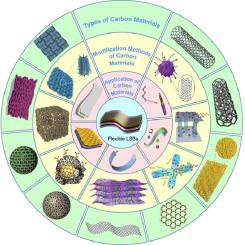Energy Storage Materials ( IF 18.9 ) Pub Date : 2023-05-16 , DOI: 10.1016/j.ensm.2023.102817 Lei Chen , Yehui Yuan , Raphael Orenstein , Meltem Yanilmaz , Jin He , Jian Liu , Yong Liu , Xiangwu Zhang

|
As a new energy storage device, lithium-sulfur battery (LSB) has a sulfur cathode with a much higher theoretical specific capacity (1675 mAh g−1) and energy density (2600 Wh kg−1) compared with current lithium-ion batteries, making it a promising candidate for the next generation of energy storage devices. In recent years, the emergence of wearable electronic devices and smart textiles has placed a new demand on energy storage batteries - flexibility. Carbon materials, namely carbon fibers and several carbon nanomaterials (such as carbon nanotubes, graphene, carbon nanofibers, porous carbon skeletons, and their derivatives) possess remarkable structural and functional adjustability, and are thus well suited for building components of flexible LSBs. These components include current collectors, interlayers, solid electrolytes and anodes. This paper systematically reviews research progress in carbon materials used in different components of flexible LSBs, including the sulfur cathode, interlayer, lithium anode, and dual-functional host carbon materials that can be used as both cathode and anode. Additionally, the relationship between the processing and modification methods and the carbon materials’ structure, flexibility, and electrochemical properties is described. Finally, the problems of flexible LSBs based on carbon materials are analyzed, and the future development trend is delineated, in a part, respectively.
中文翻译:

碳材料致力于柔性锂硫电池的可弯曲支撑
作为一种新型储能装置,锂硫电池 (LSB) 的硫阴极具有更高的理论比容量 (1675 mAh g −1 ) 和能量密度 (2600 Wh kg −1) 与目前的锂离子电池相比,使其成为下一代储能设备的有希望的候选者。近年来,可穿戴电子设备和智能纺织品的出现,对储能电池提出了新的需求——灵活性。碳材料,即碳纤维和几种碳纳米材料(如碳纳米管、石墨烯、碳纳米纤维、多孔碳骨架及其衍生物)具有显着的结构和功能可调性,因此非常适合构建柔性LSB的组件。这些组件包括集电器、夹层、固体电解质和阳极。本文系统地回顾了用于柔性LSBs不同组件的碳材料的研究进展,包括硫正极、夹层、锂负极、以及既可用作正极又可用作负极的双功能主体碳材料。此外,还描述了加工和改性方法与碳材料的结构、柔韧性和电化学性能之间的关系。最后,分别对基于碳材料的柔性LSBs存在的问题进行了分析,并对未来的发展趋势进行了展望。











































 京公网安备 11010802027423号
京公网安备 11010802027423号